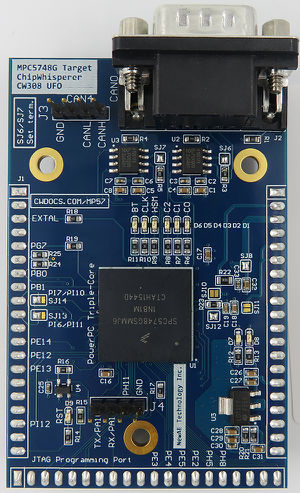| As of August 2020 the site you are on (wiki.newae.com) is deprecated, and content is now at rtfm.newae.com. |
Difference between revisions of "CW308T-MPC5748G"
(Tag: VisualEditor) |
(Format Unification) (Tag: VisualEditor) |
||
| Line 18: | Line 18: | ||
* Two serial ports (usable as LIN). | * Two serial ports (usable as LIN). | ||
* Various solder jumpers for variety of power analysis options. | * Various solder jumpers for variety of power analysis options. | ||
| − | |||
| − | |||
Intended Usage | Intended Usage | ||
Revision as of 10:15, 4 October 2017
This is a BETA target and not yet available. This wiki page will continue to be updated until release.
| CW308T-MPC5748G | |
|---|---|
 | |
| Target Device | NXP MPC5748G |
| Target Architecture | PowerPC, Triple-Core |
| Hardware Crypto | Possible |
The MPC5748G target uses the NXP MPC5748G device, which is a triple-core PowerPC microcontroller for automotive applications. This target board has a number of interesting features including:
- Two CAN interfaces, with with DB9.
- Two serial ports (usable as LIN).
- Various solder jumpers for variety of power analysis options.
Intended Usage
Overview of Features
Demo Application
The demo application provides examples of:
- Using serial interface (implements Simple-Serial).
- Using CAN interface.
- Enabling all three cores, and communicating between cores with shared memory.
- Running software AES on main core.
- Running password-check (XOR) on main core.
- Setup of clock network for using external clock from ChipWhisperer.
- Communicating with Hardware Security Module (HSM) using our proprietary library (access to library requires NDA).
Offered Variants
The product is available in three main variants. Initially only the "NORMAL" variant will be available to simplify exporting procedures.
- The "NORMAL" variant. This variant has the following setup:
- HSM is programmed with authentication-only code using hardware AES-128 (i.e., the ciphertext output is NOT available). This simplifies export processing, but the HSM code memory section CANNOT be changed or viewed. The HSM source code is not available due to NDA requirements. A special binary-only library is required to communicate with the HSM.
- The four OTP password groups have been programmed. 3 of them are known passwords you can use for experimentation, 1 is a secret unknown password used to lock the HSM code (NB: we set each device with a unique random password, so could not recover it even if we want to).
- Device lifecycle is progressed to the "OEM Production" stage. This will prevent you from doing certain updates to the memory, but for most "normal" uses will not prevent reloading of code etc.
- A simple serial bootloader is present. This bootloader is locked (to prevent overwrite) with one of the known passwords.
- The demo application is loaded.
- Device censorship is disabled (this can be turned on using an external programmer).
- The JTAG port has a known password, but is not locked (this can be turned on using an external programmer).
- The "ENC" variant:
- This variant is the same as above, BUT the HSM supports encryption (not just authentication).
- This devices will REQUIRE export documentation which entails an additional cost per order + a 1-6 week delay (dependent on Canadian processing time, normally it's faster). You may have additional restrictions at import but we cannot assist with those.
- The "RAW" variant. This variant has the following setup:
- HSM is not programmed. We cannot provide details on this usage without a NDA.
- A simple serial bootloader is present.
- The demo application is loaded.
- This devices will REQUIRE export documentation which entails an additional cost per order + a 1-6 week delay (dependent on Canadian processing time, normally it's faster). You may have additional restrictions at import but we cannot assist with those.
Most users are suggested to use the "NORMAL" variant. This variant allows you to get running immediately with our demo applications, and also program your own code into the device.
HSM Support
The Hardware Security Module (HSM) is a completely separate core (in addition to the 3 power-PC cores) present in these devices. It has a variety of features to allow secure coding. has been programmed with simple code that allows you to perform the following two operations:
- Hardware AES using accelerator built into chip.
- Software AES (for comparison purposes).
Note details of the HSM are not available. We have programmed the HSM with code to perform the above operations. In order to talk to the HSM you require a separate interface, which we provide in a binary-only "library" (RAM-based functions). This library does not actually contain any details of the HSM core itself (the code in that library runs on the main core).
Programming
The device is designed to use an external programmer, but does come with a basic serial bootloader. Details forthcoming.